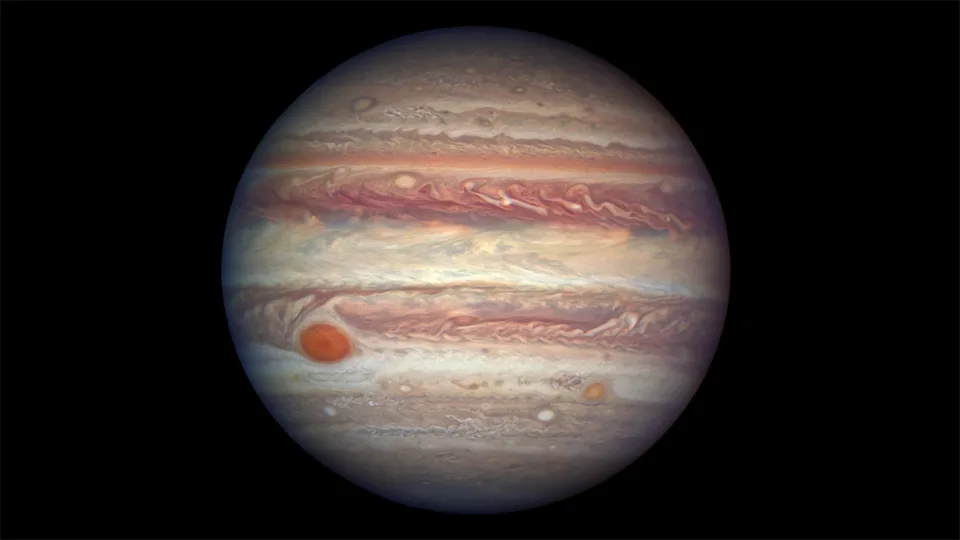
See planet Jupiter at its brightest right now!
Are you ready? Look up in the sky to see Jupiter at its brightest of the year!
Spring Astronomy Highlights
March 21 - Zodiacal Light after evening twilight, western sky for two weeks
April 22-23 - Lyrid Meteor Shower peak
April 23-25 - The Moon swings past Jupiter and Saturn
May 4-5 - eta Aquariid Meteor Shower peaks on Star Wars Day
May 8 - Mars and the Crescent Moon together at sunset
May 18 - Blue Moon
May 20-23 - The Moon swings past Jupiter and Saturn again
June 10 - Jupiter closest to Earth for the year (Opposition)
June 15-20 - The Moon swings past Jupiter and Saturn, yet again!
June 21 - Summer Solstice
MARCH 21 - ZODIACAL LIGHT
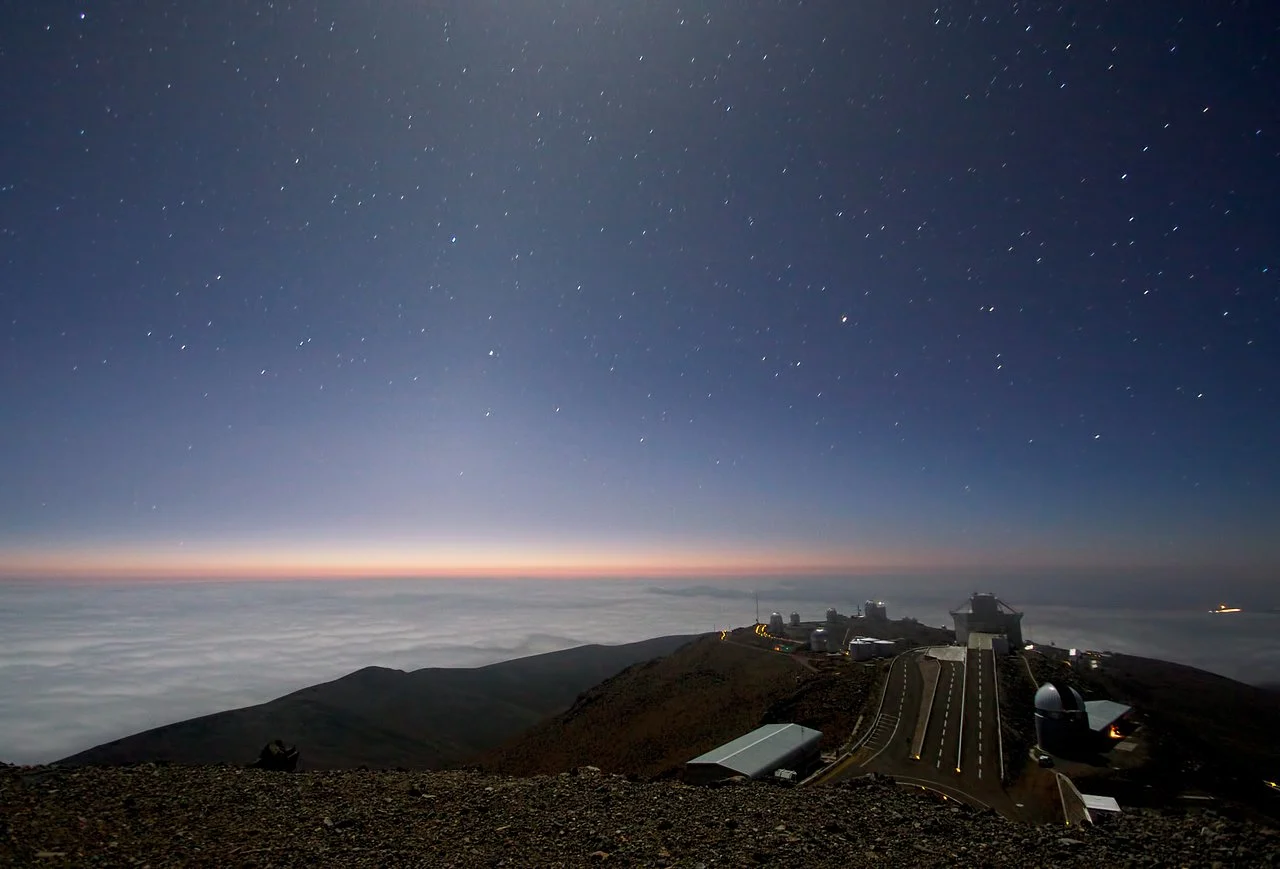
Moonlight and zodiacal light over La Silla. Credit: ESO
This spring, skywatchers will have a chance to see the immense cloud of interplanetary dust that encircles the Sun, which manifests in our night sky as a phenomenon known as "The Zodiacal Light".
In the Royal Astronomical Society of Canada's 2019 Observer's Handbook, Dr. Roy Bishop, Emeritus Professor of Physics from Acadia University, wrote: "The zodiacal light appears as a huge, softly radiant pyramid of white light with its base near the horizon, and its axis centred on the zodiac (or better, the ecliptic). In its brightest parts, it exceeds the luminance of the central Milky Way."
The zodiacal light is caused by sunlight refracting off tiny bits of dust and ice that orbit around the Sun in the plane of the ecliptic (the same plane the planets orbit in). It's thought that this cloud originates from dust and ice blown off of comets.
According to Dr. Bishop, even though this phenomenon can be quite bright, the light is so diffuse that it can easily be spoiled by moonlight, haze or light pollution. Also, since it is best viewed just after twilight, the inexperienced sometimes confused it for twilight, and thus miss out.
On clear nights, and under dark skies, look to the western horizon, in the half an hour just after twilight has faded, from about March 21 to April 5.
Look for a pyramid-shaped white glow, with the base along the horizon and the point angled towards the south.
APRIL 22-23 - LYRID METEOR SHOWER PEAK
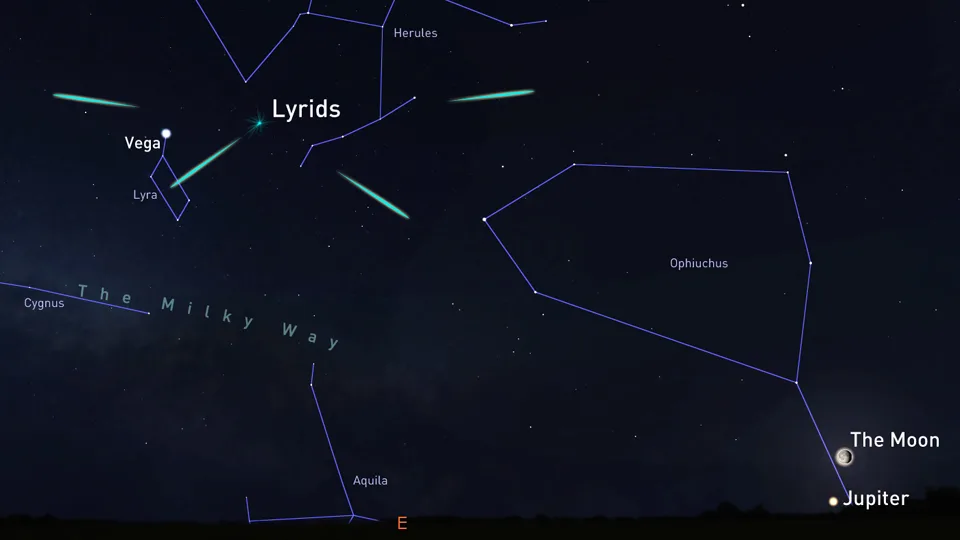
The "radiant" of the Lyrid meteor shower, roughly at midnight, on April 22-23. Credit: Stellarium/Scott Sutherland
On the night of Monday, April 22 to Tuesday, April 23, the Lyrid meteor shower reaches its peak.
Lyrid meteors originate from a stream of dusty, icy debris left behind by Comet C/1861 G1 Thatcher, and the streaks across the sky occur when Earth passes through that stream, and the atmosphere 'sweeps up' some of that dust and ice.
While the stream is fairly sparse, delivering only around 20 meteors per hour, at best, embedded within this stream are some larger bits, which are capable of producing fireballs!
The best time to watch is in the hours after midnight, however the light from the nearly Full Moon will wash out the dimmest meteors of this shower, even for those who are able to escape urban light pollution.
According to the International Meteor Organization's meteor shower calendar, it presents good activity on the nights before and after the April 22nd peak.
APRIL 23-25 - JUPITER AND SATURN IN LUNAR CONJUCTION
Right after the Lyrids reach their peak, keep watching the skies for a few nights, not just for the chance to see a few more meteors pass overhead, but also because over the next three nights, the Moon will pass by the two largest planets in our sky.
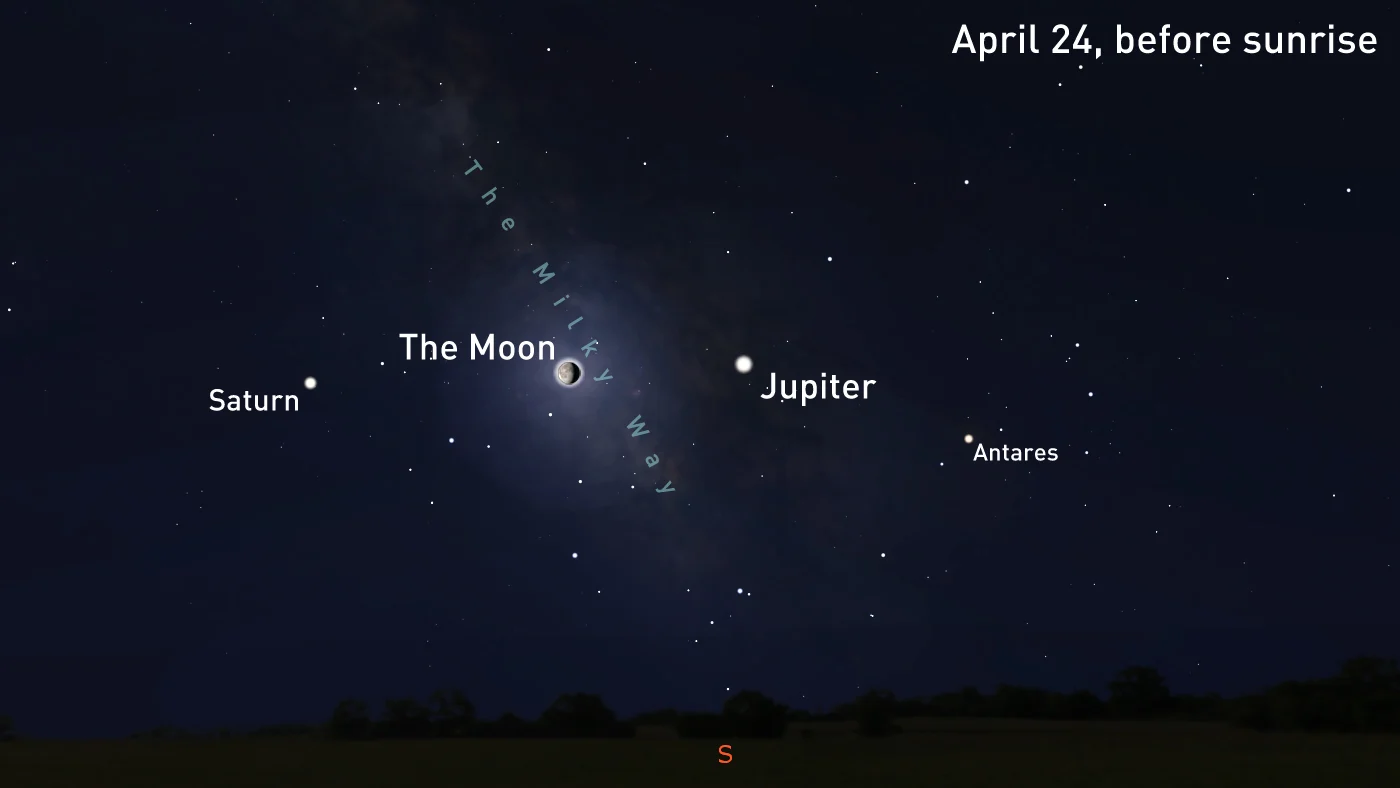
The image above reveals the night sky in the hours before dawn, on April 24, as the Moon's path brings it into conjunction with Jupiter, and then Saturn. Credit: Stellarium/NASA GSVS/Scott Sutherland
MAY 4-5 - STAR WARS DAY AND THE ETA AQUARIID METEOR SHOWER PEAK
Comet Halley is probably the most well-known comet in the world, passing by our planet and putting on a spectacular show, every 75 years. Perhaps less well-known is the fact that it is the only comet we know of that produces two major meteor showers each year!
The eta Aquariids, which peak on the night of May 4-5, is the first of these two meteor showers.

The "radiant" of the eta Aquariid meteor shower, in the hours before dawn, on May 5. Credit: Stellarium/Scott Sutherland
The best time to see the eta Aquariids is in the hours before dawn on May 5, since the radiant only rises above the eastern horizon at that time.
This year, the thin Crescent Moon will have long set by the time the meteor shower starts, so just find a place far from light pollution and look up to enjoy the show.
The eta Aquariids typically produce around 50 meteors per hour, under ideal conditions (clear, dark sky, with the meteor shower radiant directly overhead). Most observers will likely see a couple of dozen per hour, but possibly more depending on sky conditions. While this shower does not tend to produce bright fireballs, the meteoroids are moving so quickly when they hit our atmosphere that they can produce a phenomena called persistent trains.
Watch below to see a persistent train from a different meteor shower
Persistent trains are colourful, faintly glowing streaks that can persist in the sky from a few seconds to several minutes after the meteor that caused one has winked out. Some have even been observed for hours afterward!
What causes this phenomenon is the exceptional speed of the meteoroids in Comet Halley's stream of debris.
When a typical cometary meteoroid passes through the Earth's upper atmosphere, it is travelling at around 100,000 km/h. Moving at that impressive speed, it compresses the air molecules in its path, causing them to superheat and glow. This glow persists for as long as the meteoroid exists, or at least as long as it is travelling fast enough to continue compressing the air. As soon as the meteoroid either vapourizes, or it is slowed down enough by the atmosphere, the meteor light winks out.
The particles in the eta Aquarid stream hit Earth's atmosphere travelling at more like 240,000 km/h.
At nearly 2.5x the normal speed, these meteoroids not only produce the bright meteor flash, but they can also result in an added bonus - a glowing trail left behind, floating in the air.
Since persistent trains have only rarely been recorded, scientists still aren't quite sure exactly what causes them. They have two basic ideas, though.
The first is that the meteoroids are travelling fast enough to actually strip electrons from the air molecules, leaving them in an ionized state. As the air molecules reclaim those liberated electrons, they release energy in form of light. Since this process can take much longer than the original meteor flash, the 'train' persists in the air afterward.
The other idea is that metals vapourized off the fast-moving meteoroids can chemically react with ozone and oxygen, to produce a glow via what's known as 'chemiluminescence'.
One of these explanations may account for these 'trains', or both may cover different occurrences, at different times, and even between individual meteors. It will take more sightings of these to fully explain them.
MAY 8 - MARS IN CONJUNCTION WITH THE MOON

Mars and the thin crescent Moon team up after sunset on May 8. Credit: Stellarium/NASA GSVS/Scott Sutherland
It's not easy to pick Mars out in the sky this season (or the next), since it is spending most of its time lurking in our daytime sky, as it heads for solar conjunction in early September.
We can catch a glimpse of it in the western sky, just after sunset, as it pairs up with a thin Crescent Moon, on the night of May 8. Look for a 'celestial cross' formed by four bright stars - Pollux, Capella, Betelgeuse and Procyon, and towards the bottom left, you will spot the Moon and Mars.
MAY 18 - THE BLUE MOON
So, last year, our big astronomy event was January's Super Blue Blood Moon Total Lunar Eclipse. As we explained during that event, the "blue" part of that title came from the fact that it was the second Full Moon in a calendar month.
Although that has become a popular definition, it's also an incorrect one. An actual 'Blue Moon' is the third Full Moon in a season with four Full Moons.

Normally, there are three Full Moons every season. Every three years (or two years, if there's a leap year in between), the first Full Moon of a season will occur right when the season starts, or within a few days after. Since a lunar month is shorter than most calendar months, the three Full Moons that follow will also occur in that same season. The last time we saw this was in the spring of 2016.
For Spring 2019, Full Moons fall on the dates of March 20, April 19, May 18, and June 17. March 20 is also the date of the Equinox, however the actual timing of when the Sun crosses the celestial equator (5:58 p.m. EDT) is before the Moon becomes completely full (9:43 p.m. EDT), so it counts!
So, the May 18 Full Moon is the third Full Moon in the season, and thus an actual Blue Moon!
Note that the Moon will not actually turn the colour blue on that night, unless there are very specific, even rarer meteorological conditions present.
MAY 20-23 - JUPITER AND SATURN IN LUNAR CONJUCTION
For the second time this season, The Moon will swing past Jupiter and Saturn!
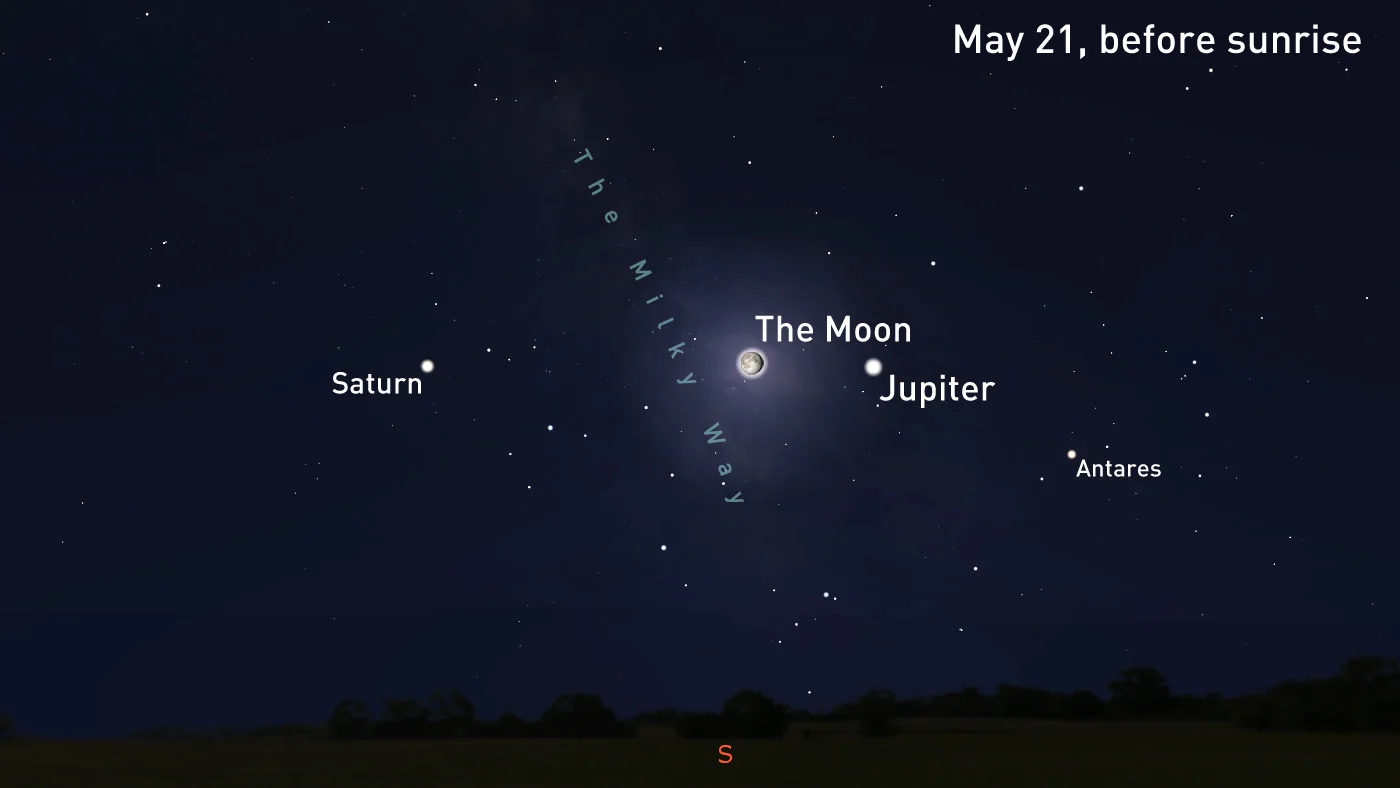
The image above reveals the night sky in the hours before dawn, on May 21, as the Moon's path brings it into conjunction, once again, with Jupiter, and then Saturn. Credit: Stellarium/NASA GSVS/Scott Sutherland
JUNE 10 - JUPITER OPPOSITION
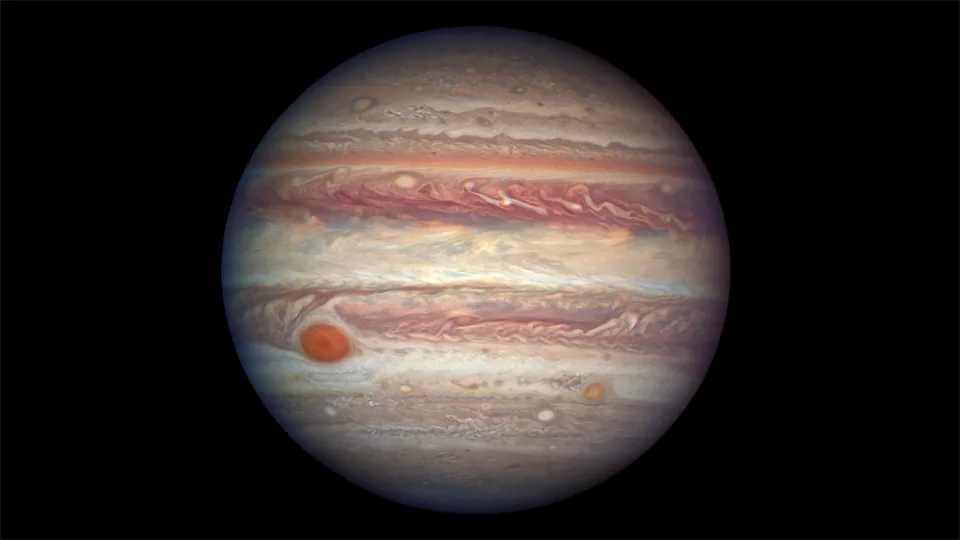
Jupiter, c/o the Hubble Space Telescope, on approach to Opposition in 2017. Credit: NASA/ESA
On the nights of June 9-12, the planet Jupiter will be at its biggest and brightest in our night sky.
It reaches Opposition - the point in its orbit when it is on the exact opposite side of Earth from the Sun - in the morning hours of June 10, and it reaches its closest point to Earth on June 12.
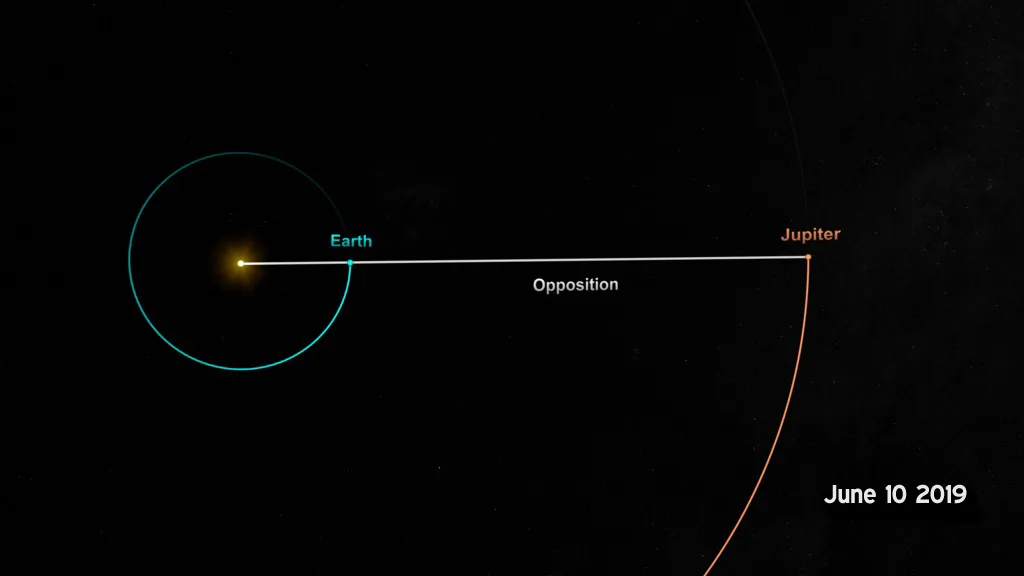
The orbital positions of Earth and Jupiter, on the morning of June 10, 2019. Credit: NASA/Scott Sutherland
Don't worry if we miss the exact timing of opposition, due to sunrise. We'll have a big, bright Jupiter for days, before and after the event.
Viewing the planet is best with a telescope or a good pair of binoculars, which also gives the planet-gazer the opportunity to see the four Galilean moons of Jupiter - Io, Europa, Ganymede and Callisto.
Otherwise, the planet will appears as an exceptionally bright 'star' to the naked eye.
JUNE 15-20 - JUPITER AND SATURN IN LUNAR CONJUCTION
In the days leading up to Summer Solstice, we will have a third pass of the Moon by Jupiter and Saturn, with a conjunction with each planet along the way.
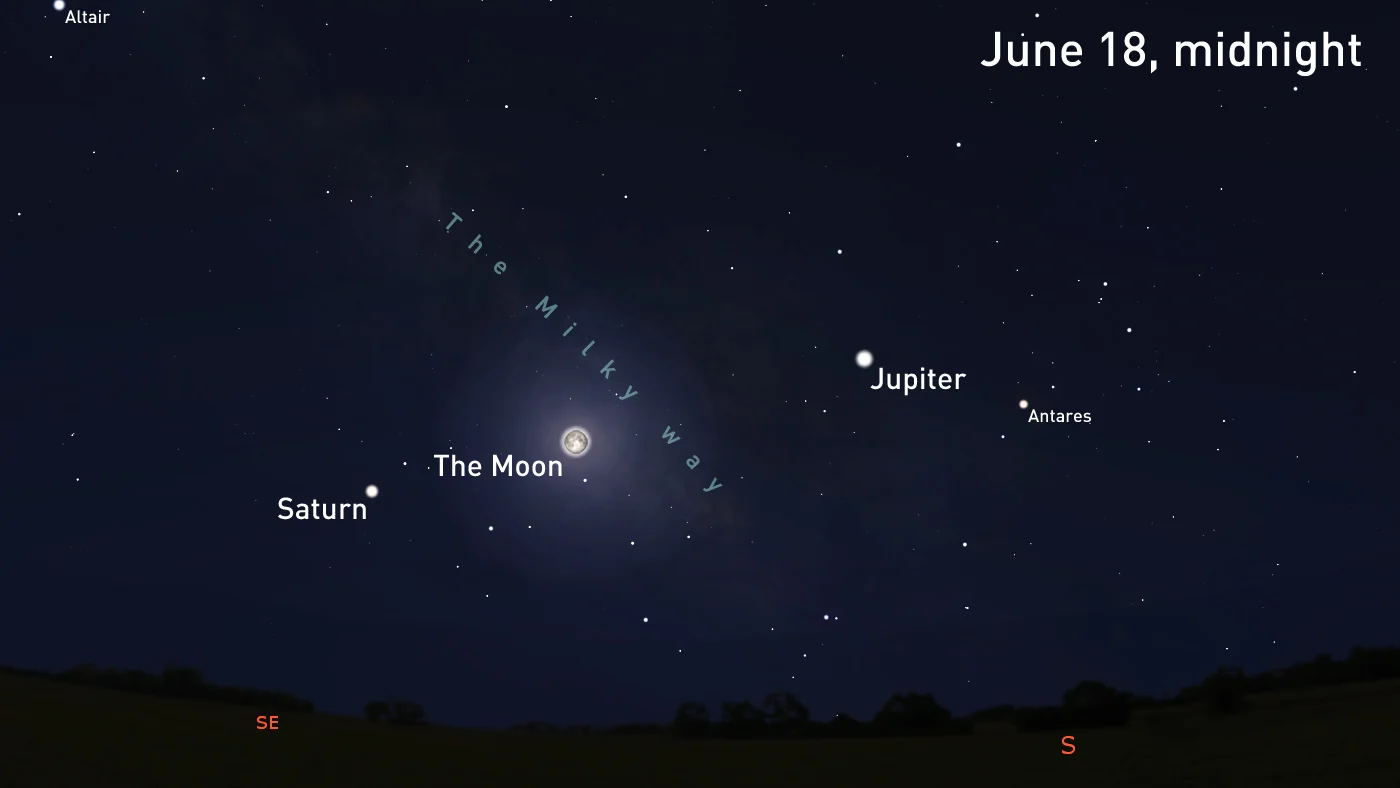
The image above reveals the night sky around midnight for June 18, when the Moon is between Jupiter and Saturn. Credit: Stellarium/NASA GSVS/Scott Sutherland
Although the image above shows only June 18, watch between June 15 to 20, to see the Moon pass close to Jupiter, and then Saturn.
JUNE 21 - SUMMER SOLSTICE
On June 21, at 15:54 UTC, or just minutes before noon in the eastern time zone, the Sun will reach its highest point in the northern sky for 2019.
This marks the start of Summer in the northern hemisphere and the start of Winter in the southern hemisphere.
It is also the longest day of the year for the northern hemisphere, but exactly how long will depend on where you live (and how close to the north pole you are). For example, Toronto will see 15 hours, 26 minutes and 31 seconds of daylight on this day, while Edmonton, farther north, will see 17 hours, 2 minutes and 42 seconds of daylight.
Sources: IMO | RASC | TimeandDate.com | With files from The Weather Network






